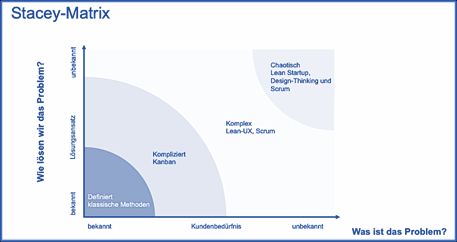Our working world is not only becoming increasingly complex, it is also subject to constant change - and this is happening at a rapid pace. In trying to keep up with this progress, conventional working methods often reach their limits. This is why organizations today are increasingly relying on self-organized teams - supported by agile methods and procedures.
What do we mean by self-organization and what are self-organized teams?
By self-organization, we mean the ability to complete complex tasks and solve problems in a particularly flexible, creative and productive manner under one's own responsibility. Within the organization, we speak of self-organized teams.
This is a group of people who pursue a common goal and decide on the WHAT and HOW of their work process independently of external factors. A self-organized team organizes itself in such a way that it optimally handles the tasks at hand. It can therefore act independently and find solutions.
Freedom with a "guard rail": Self-organization also needs structure
However, self-organization does not mean that the team members can decide everything themselves and operate in an unlimited space. Simply providing the freedom for self-organized processes is often not enough. Self-organized teams need clear framework conditions and rules so that they can develop well. Certain conditions and structures must be created to ensure meaningful and efficient collaboration.
Agile methods in projects such as Scrum or Kanban, for products such as Design Thinking or Lean UX or for agile corporate development such as Holacracy provide such a framework.
The Stacey matrix as a guide?
Depending on the organizational or project environment in which we operate, some agile methods are more suitable than others. Agile management is not always necessary; sometimes a "traditional" approach is also suitable.
It is important to find the right mix of methods by creating an understanding of which challenges are complex and how. Intermediate stages and "hybrid" approaches are common practice.
The Stacey matrix (based on Ralph D. Stacey) can be used to select agile methods that fit perfectly.

Success through social skills
In order to be able to work together successfully in the long term, self-organized teams need social skills. This "social maturity" is expressed in a responsible, value-conscious and self-reflective mindset. Its existence cannot be taken for granted; it must be particularly encouraged in a self-organized team and needs time to develop.
In self-organized teams, values and principles are the basis for good cooperation and successful communication. But what does optimal collaboration look like?
Let's start by looking at the values: these must be discussed together in the team and then put into practice. The key question is: What is really important to us?
These 4 values are often found in self-organized teams and form the foundation:
- Respect
- Commitment
- Simplicity
- Courage
Other important values:
- Feedback
- Focus
- Communication
- Openness
Important: Values are not fixed "if-then rules", but express an attitude that can be flexibly filled with life depending on the situation.
What are principles or working principles?
Working principles are guidelines that are so well founded and documented that they no longer need to be questioned in everyday life and therefore help to simplify and speed up decisions. "Keep it simple" is the motto!
The key questions are:
What are we doing this for?
What do we want to achieve?
Here are a few examples of principles that are frequently encountered in agile teams:
Accepted responsibility: Accepted responsibility is self-motivated and arises when employees not only know the meaning and purpose of their project/product, but also want to contribute to it.
Making work visible: Only the appropriate representation of the development process, including the associated workflows, enables real coordination within the team, as this visualization helps to review and improve workflows.
Empowered team: The accepted responsibility of a team increases in proportion to its authority to make decisions. As this authority can only be granted from above, it makes sense to involve management closely in the implementation of agile methods.
Look at the big picture: Responsibility should never be distributed exclusively locally. Otherwise, a system of local optimization is created in which employees, teams or even entire departments compete with each other to achieve the optimum result. Responsibility should therefore always be defined as broadly as possible and then achieved collectively.
Reinforce learning: Sustainable innovative strength requires continuous training and development of employees. Particularly with regard to their technical skills and the evaluation of existing processes and functional content of the products/services to be developed.
Reflective improvement: The willingness and desire to continuously improve by regularly questioning and reviewing current conditions.
Deliver as quickly as possible: This refers to the fastest possible delivery of functioning interim results. This is made possible by the mutual exchange of rapid feedback on the current product or service and the requirements for the future product.
Eliminate waste: By focusing on the requirements and functionalities that are actually needed, superfluous work and features can be avoided. For example, actively omitting "nice to have" features or the technically "most beautiful" solution can contribute to this.
For a self-organized team to perceive its collaboration as motivating and meaningful and to be able to work very efficiently, many other topics are of course important. Roles + accountabilities, decision-making techniques, communication and a culture of conflict and error.
We discuss and learn about these and other topics in my training "Self-organized teams". Interested?




